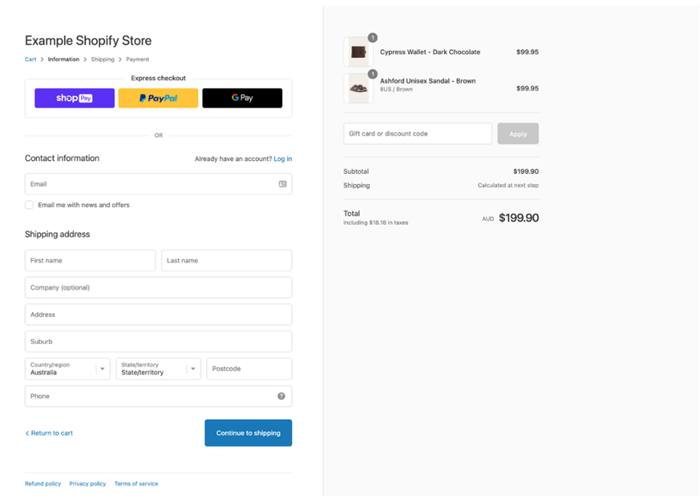Managing Editor’s Note: Don’t forget to sign up with one click for Larry Benedict’s Market Divergence Summit tomorrow afternoon at 2 p.m. ET…
He’s revealing his strategy to profit from the short-term distortions that are kicking up… the sort that often come when there is a disconnect across the headlines, the data, and how the market is moving.
Larry is no stranger to fast-moving, high-volatility markets. And he has just the way to take advantage of these short-term market snaps. Just go here to automatically add your name to the guest list for tomorrow, August 7, at 2 p.m. ET.

For those of us who routinely shop online – which, by now, is almost all of us – Amazon (AMZN) and Shopify (SHOP) changed the game…
The two companies have transformed shopping for the everyday consumer. The secret to their success was simple… they removed friction for consumers in shopping and transacting online.
They have flourished thanks to a fairly straightforward business model of making it fast, easy, and convenient to shop online.
Whether it was creating a one-stop shop for finding and purchasing items that we want or need, or enabling a seamless checkout across millions of online merchants.
And with the oncoming rise of agentic artificial intelligence, we’re on the cusp of another significant shift in the e-commerce world…
Amazon’s e-commerce business now operates in 22 countries and ships to more than 100 countries around the world. In the U.S., 56% of consumers start their product search on Amazon, not Google.
This was a massive shift in e-commerce, the shift from using a search engine to find what we need to using Amazon. This resulted in Amazon’s incredible rise to a $2.3 trillion and growing company.
Shopify, on the other hand, started as a business-to-business (B2B) software company.
Its goal was simple: to make it easier for merchants and e-commerce companies to sell their products online. Shopify’s software abstracted away the complexity of e-commerce transactions online, enabling a similar one (or two) click experience just like Amazon.
Shopify’s approach was so seamless and simple, it removed so much friction from buying online that many people used Shopify’s technology and didn’t even realize it.
Shopify understood one major problem… It recognized the friction in e-commerce transactions that resulted in lower sales.
That problem was that whenever consumers went to a new merchant’s website and filled their cart, many consumers wouldn’t complete the transaction due to the hassle of having to open “yet another account, create more usernames and passwords, provide billing and shipping addresses, and provide credit card information.”
Shopify recognized that all that information was duplicative. It was the same information over and over. It was a major hassle. And it solved that problem with its Shop Pay accelerated checkout system.
Shopify stores that information for consumers and integrates its enterprise software with merchants and e-commerce companies around the world.
And consumers saw none of the software complexity, only simplicity. Below is an example of a Shopify-enabled transaction on checkout.

Example Shopify Store | Source: Christopher Dodd
All consumers have to do is enter their e-mail address. With that single piece of information, all fields populate with address and credit card information, and from there, it is one click to finish a purchase.
Voila! Simplicity. The friction is gone. It became a major time saver and removed the frustration of doing the same things over and over again.
Shopify’s solution may seem obvious, but no one else had innovated at scale like that before. Today, Shopify has more than 875 million unique online shoppers annually, more than 12% of the U.S. e-commerce market, and literally millions of merchants in more than 175 countries who conduct business online.
While Shopify is worth “only” $160 billion today – a small fraction of Amazon’s valuation – I can make a strong argument that Shopify’s reach in e-commerce is far greater than Amazon’s on a global basis.
And that’s why what’s coming in the months ahead is so significant. In fact, what’s coming is the next massive shift in shopping since Amazon and Shopify’s innovations.
This next trend will prove to be far more friction-free than anything we’ve seen before. And it will likely be the “ah-ha” moment for consumers to grok the power of artificial intelligence, specifically agentic AI.
The “ah-ha” moment is when it clicks for people just how incredible artificial intelligence truly is, and how significant an impact it will have on our everyday lives.
And for most, that moment will come when they experience an AI that addresses or solves, with unparalleled ease, some sort of real-world task for them, particularly those that tend to take up a lot of our time.
Something like the hours spent combing the internet for a gift, a product, a service, reduce to the seconds it takes to put an agentic AI on the task instead.
Yesterday, Shopify just announced that it has built agentic AI software into its software platform.
Consumers can use their personalized AI agents to shop for products across the millions of merchants that use Shopify’s software.
What this means practically is that we’ll be able to prompt our AI agents with things like “please send some flowers to Mike Smith’s home with our condolences, about $100.” That’s it, that’s all it will take. Done. And if our personalized agentic AI needs to confirm something with us, it will.
Shopify is also implementing this technology within its own Shop application, assisting its shoppers with the same technology, directly with consumers. Below is a short video of what that looks like:

Source: OpenAI
Personalized AI agents will know us, our family members, and all our shopping preferences. “They” will even know what brands we prefer, our budgets for certain items, our sizes, and a whole lot more. And they’ll make new product discovery not only frictionless, but also fun and exciting.
But Shopify is just part of the picture. While Shopify has its own agentic AI capabilities built into its software platform, the general-purpose personalized AI agents are already being built by the leading AI companies building foundational AI models in their race to artificial general intelligence (AGI).
Just a few weeks ago, OpenAI announced “ChatGPT Agent,” its agentic AI that can think, reason, problem solve, and complete tasks like sourcing and purchasing products without the need for any intervention on our part.

Source: Shopify
Above, you’ll see a GIF of an agentic AI at work. Here was the prompt used…
Create an anime-style sticker of my company’s mascot, then order 500 stickers and send them to 4187 Starfall Avenue.
And of course, it’s not just OpenAI. Google shared at its annual I/O conference Project Mariner, which is its agentic AI solution capable of doing the same kinds of tasks.
Coming a bit later this year is Google’s Project Astra, which I’ve written about before, which is a multi-modal AI model enabling consumers to just speak and interact verbally with an AI agent.
And of course, the recently released Grok 4 from xAI is built with agentic AI capabilities.
So while xAI hasn’t yet launched personalized AI agents to its users, it does have a multi-modal platform that will further incorporate audio, vision, and agentic capabilities that will be the foundation for launching personalized agents. We may be just weeks away…
What’s the significance of all this?
Well, it means that consumers will have their choice of personalized AI agents from a range of AI companies.
Some will be “free,” but will come at the “expense” of the loss in privacy, meaning a Google-like advertising model where access to your data will be sold to the highest bidder, and your search results will be influenced heavily by advertisers.
And some will be subscription-based and designed and optimized to be neutral and unbiased.
Either way, these agentic AI systems will be integrated directly with Amazon, Shopify, and many other e-commerce platforms to enable seamless, friction-free commerce transactions, all at our fingertips. Or more accurately, all at a single text or voice prompt.
And we won’t have to wait years for this technology. It already exists today. We’re weeks away from the “ah-ha” moment, a world full of personalized agentic AI.
Jeff
The Bleeding Edge is the only free newsletter that delivers daily insights and information from the high-tech world as well as topics and trends relevant to investments.
The Bleeding Edge is the only free newsletter that delivers daily insights and information from the high-tech world as well as topics and trends relevant to investments.